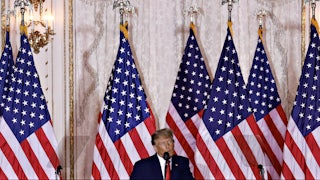We can’t predict if the United States will survive as a democratic republic until 2050. It’s barely one in 2022. But we can imagine what it would take to make it one. In fact, for the survival of millions of Americans and billions around the world, we must ensure it does.
To do so, we should boldly articulate a vision for the United States that we have only occasionally aspired to convey: that of a fully democratic, cosmopolitan republic that finally rejects white supremacy as an organizing American ideology. It should be one that values and strengthens deliberation as the chief instrument of decision-making. And it should emphasize that we have a shared fate—not only as Americans but as humans on a threatened planet. Anything less risks disaster, both slow and fast.
The United States has undergone several “constitutional moments,” as Yale Law professor Bruce Ackerman has defined them. These are moments that start as a crisis and end in resolution. The resolutions result from the forging and harnessing of competing public visions of the good. These moments of crisis sparked deep deliberation among those who were allowed to speak and be heard—mostly wealthy white men, of course. The three main deliberative moments in Ackerman’s schema were the ratification of the Constitution, Reconstruction, and the New Deal. Each of these generated a brand-new covenant among the people and between the people and the state. The twenty-first century, starting with Bush v. Gore and culminating in the invasion of the Capitol on January 6, 2021, has found us in another such constitutional moment.
We often misdiagnose our current malady as one of “polarization.” That’s wrong. We have one rogue, ethno-authoritarian party and one fairly stable and diverse party. It just looks like polarization when you map it red and blue or consider these parties to be equal in levels of mercenary commitment, which they overwhelmingly are not. In one sense, America has always been polarized, just not along partisan lines. It’s also been more polarized rather recently, as in 1919 or 1968.
Instead, we suffer from judicial tyranny fueled by white supremacy. One largely unaccountable branch of government has been captured by ideologues who have committed themselves to undermining the will of the electorate on matters ranging from women’s bodily autonomy to voting rights to the ability of the executive branch to carry out the policy directives of Congress by regulating commerce and industry.
Judicial tyranny has been harnessed by and promoted by a political party freshly and boldly committed to ethnic nationalism, expressed as general xenophobia and specific limitations on access to power and opportunity for immigrants and minority groups. Tucker Carlson and Donald Trump are the loudest voices championing this movement. But less conspicuous, less vituperative voices within corridors of power do just as much damage.
Americans, lacking a natural sense of nationhood, have been bound through most of U.S. history by a loose collection of ideological commitments, including commitment to personal liberties, optimism about the future, and trust in military and corporate prowess to solve problems. But we should recognize that white supremacy has long been the glue that held much of America together. As historian Edmund S. Morgan described in his essential 1975 book, American Slavery, American Freedom, white identity unified white colonists in Virginia across class lines, defining the very idea of “freedom” as “not slavery,” or “not blackness.” Slaveholding elites in Virginia saw the dangers of potential class solidarity among Native workers, enslaved Africans, and white indentured laborers, so they constructed a pan-white political identity that defined whiteness as freedom and ensured that poor white people would have a stake in the racial hierarchy regardless of their lack of status and power. For poor whites, at least they would not be Black slaves. So for white Virginians (and soon white Americans in general), a struggle for freedom was a struggle to assert superiority or dominance over nonwhite people. That idea has changed its tenor, often expressed in whispers rather than whipcracks, but it has never lost its power.
In this constitutional moment, we finally have a chance to toss away white supremacy as a core ideology that makes America America. We could, with effort, diligence, and courage, replace it with a multiethnic, cosmopolitan sensibility. But to do this, we would have to bluntly acknowledge that white supremacy drove America this far—both up the mountain and into a ditch. And we must declare that we aim to rid America of its attachment to white supremacy, to render it visible and shrink it to manageable size.
Instead, we should adopt a vision for the best possible America for this century, one that acknowledges that people, money, goods, and expressions are going to flow across borders and oceans, but that embraces justice and human flourishing as the ends of that process instead of morally vacant values like efficiency or productivity. We should imagine and promote an America that embraces “xenophilia,” as cultural theorist Leela Gandhi advocates: a full embrace of the other, the foreign, the different, as something that adds value to life. It would mean escaping from the zero-sum idea of the other “taking” something from “us.”
I would reject the idea that the United States could sever itself along geographical lines without inviting the sort of nonstate violence that visited India and Pakistan in 1947, the family separation that hindered East and West Germany from 1946 through 1989, or the financial and economic chaos that existed under the Articles of Confederation and that we are seeing in the U.K. post-Brexit. No one should underestimate the pain and dislocation to people and institutions that would flow from such a divorce. If one state or region lurches fully into fascism and institutes forced removal or genocide, the pain would be obvious and severe. But even administrative separation and low-level border harassment and violence, as we see in Palestine, can cause great stress to families and communities. Borders are problems.
We don’t really have a choice to avoid fighting for a new, cosmopolitan American identity. The other path seems to be some form of dissolution or the imposition of broader forms of national tyranny. There are no natural boundaries or any lines that demarcate clear political or ethnic divisions in the United States or within any of the states. Our red-and-blue maps are misleading. Solid-blue Dallas County, Harris County, Bexar County, and Travis County contain about 40 percent of the population of Texas, yet each of those counties has hundreds of thousands of Republicans. Almost 47 percent of 2020 Texas voters preferred Joe Biden. California is home to more Trump voters than Texas is. The idea of sacrificing the legal rights and perhaps disenfranchising almost half of any state is too immoral to consider.
Our vision of this country should not be dictated by the historical accident that was the Electoral College or state boundaries drawn in a completely different era. We should not wish Republican tyranny on the 45 percent of Texans who regularly reject their state’s leaders. We should help them fight, as we helped the East Germans. We should strive to liberate the oppressed, not sacrifice them.
In fact, what we hope will be a short-lived experiment in a patchwork of women’s reproductive rights should demonstrate to most Americans that traditional federalism and regionalism are not workable in the twenty-first century. The more serious question is whether the nation-state can address the challenges of the balance of this century. While the Anti-Federalists rendered some devastating critiques of the Constitution, anti-federalism that leads to sectionalism or regionalism is no more appropriate for this moment than federalism.
We should go in the opposite direction. We should push for a transnational, cosmopolitan, multicultural America that boldly recognizes its potential to deserve some sort of moral leadership and thus policy leadership in a world threatened by forces that transcend borders and oceans. We have justifiably forgotten the lamentable strand of thought from the 1990s that pondered the dissolution of the nation-state because it got attached to neoliberalism/globalization/“Washington consensus”/“World Is Flat” nonsense and then collapsed with the World Trade Center.
Now, facing the prospect of global, infectious diseases, massive human migration, and devastating effects of climate change, we must accept that one nation cannot address any of these threats adequately. We should forge a vision of collective governance among democracies that can render some policy decisions global, while reserving other areas national and local. We need a bigger, bolder, more demanding sense of American citizenship and global responsibility. We have been cowering so much from recent political turmoil that we have neglected to generate a positive vision for a better future. It would be a daunting political project, should we choose to accept it. It will be necessary to survive this century, not only as Americans, but as humans.






